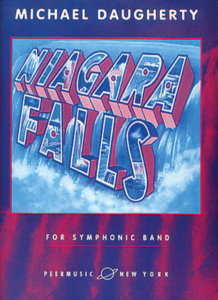Niagara Falls
for symphonic band (1997)
Instrumentation: Piccolo, 4 flutes, 3 oboes, English horn, Eb clarinet, 3 clarinets in Bb, bass clarinet, 3 bassoons, contrabassoon; 2 alto saxes, tenor sax, baritone sax; 4 horns, 4 trumpets, 3 trombones, 2 euphoniums, 2 tubas; timpani, 6 percussion (I: glockenspiel/xylophone; II=vibraphone; III=marimba; IV=chimes/glockenspiel; V=bell tree,wind chimes/3 triangles (l,m,s)/medium ship bell (fire bell/ice cymbal)/claves/bass drum/suspended cymbal/tambourine/large crash cymbal; VI=high congas/high bongos/vibraslap/suspended cymbal/whip/ratchet); harp, organ/synthesizer; double bass
Publisher:
Peermusic Classical, BMI (Americas and Asia)
Faber Music (Europe, Australia and New Zealand)
Duration: 10 minutes
World Premiere: October 1997 / Hill Auditorium, Ann Arbor, Michigan / University of Michigan Symphony Band / H. Robert Reynolds

Program Note:
Niagara Falls (1997) was commissioned by the University of Michigan Symphonic Band in honor of its One Hundredth Anniversary and is dedicated to its conductor H. Robert Reynolds. The work was premiered by that ensemble on October 4, 1997 at “Band-O-Rama,” conducted by H. Robert Reynolds at Hill Auditorium, Ann Arbor, Michigan.
The composer writes:
“Niagara Falls, a gateway between Canada and the United States, is a mecca for honeymooners and tourists who come to visit one of the most scenic waterfalls in the world. The Niagara River also generates electricity for towns on both sides of the border, where visitors are lured into haunted houses, motels, wax museums, candy stores, and tourist traps, as well as countless stores that sell Niagara Falls postcards, T-shirts, and souvenirs.
This composition is another souvenir, inspired by my many trips to Niagara Falls. It is a ten-minute musical ride over the Niagara River with an occasional stop at a haunted house or wax museum along the way. Its principal musical motive is a haunting chromatic phrase of four tones corresponding to the syllables of “Niagara Falls,” and repeated in increasingly Gothic proportions. A pulsing rhythm in the timpani and lower brass creates an undercurrent of energy to give an electric charge to the second motive, introduced in musical canons by the upper brass. The saxophones and clarinets introduce another level of counterpoint, in a bluesy riff with a film noir edge. My composition is a meditation on the American Sublime.”
